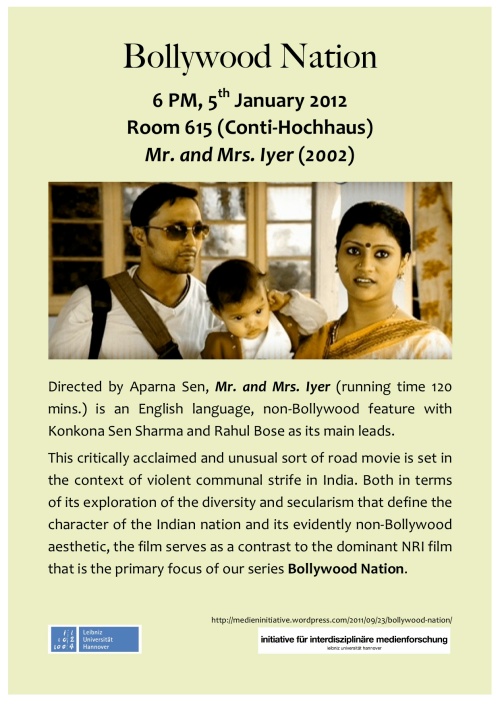
On the occasion of the first screening in our Bollywood Nation film series, which is set to begin in just under an hour from now (with Swades – more info below, and here), Jatin Wagle has put together the following very useful background information on Bollywood and tonight’s film.
Bollywood Nation
27.10.2011 – Swades: We, the People [Homeland] (Dir. Ashutosh Gowariker, 2004, 187 mins.)
Bollywood: A widely accepted but not unproblematic term for Hindi/Urdu/Hindustani language commercial cinema in India. The expression is problematic because it suggests a close relationship with or dependence on Hollywood. Even as American popular cinema remains an important frame of reference and influence for Hindi cinema, straightforward comparisons are not necessarily useful. Although the films are actually shot all over the world, the undisputed site of production of commercial Hindi cinema is the megacity of Mumbai (or Bombay as it was called before 1995). In this sense, Bollywood is both about India and Mumbai, or to be more precise, about the Indian nation as it is constantly imagined and staged in the crowded, multilingual diversity of the metropolis.
There are no clearly defined genres in Hindi commercial cinema. Instead, a typical Hindi film contains varying elements of romance, melodrama, action and comedy interspersed with song-and-dance sequences. The principal reason for this has been the complex mode of production – called “disaggregated” by M. Madhava Prasad – and the precarious mode of distribution of films in India. Although Hindi cinema has been perhaps the most significant site for the social/cultural negotiation of the Indian nation, until 2001 it was not accorded the status of an industry by the Indian Government. This has meant that over the years Hindi films have been financed through more-or- less informal networks, and this financial precariousness lies at the root of Hindi cinema’s reluctance to fragment its potential audiences. This used to be evident until a few years ago, i.e. before the advent of the multiplexes, in the typical experience of watching a Hindi film in an Indian city, when one invariably watched it with the family in a “cinema theatre” with a seating capacity of around a thousand. Thus, instead of genres, Hindi commercial cinema has historically developed a range of masala [Gewürzmischung] or formula films, i.e. mixes of or compromises between plot compositions, narrative structures and genre elements. For instance, the popular masala films of the 1970s were slight variations on either the lost-and-found/family reunion plot (e.g. Yaadon Ki Baaraat 1973) or the angry young man action hero format (e.g. Deewaar 1975, Amar Akbar Anthony 1977). From the mid-nineties, a new sort of masala film has become popular, with a diaspora setting (or at least a strong diaspora component) and an NRI (non-resident Indian) protagonist who portrays a guiltless blend of so-called Indian tradition with Western modernity.
Swades: We are beginning our film series titled, needless to say with obvious irony, “Bollywood Nation” with a film aptly called Homeland. Even with its NRI protagonist, played by Shahrukh Khan, and its partial diaspora setting, this film is untypical for a variety of reasons. Its expatriate protagonist is different from the typical hero of the recent NRI masala film. Although successful in the West, he is plagued by the guilt of having left behind the land of his past, a developing, third-world country with its complicated challenges, for a relatively uncomplicated life in the U.S. In terms of its aesthetic, the film is not obviously “camp” [filmy] and has been described as more “realistic” than a typical Bollywood film. Although it was not really a box office success within India, Swades sold well in what have been called the diaspora markets, and its music composed by A. R. Rahman became popular even within India. Ashutosh Gowariker, who wrote the script, and produced and directed the film, is known for at least one more film, Lagaan [Land Tax] (2001), which was nominated for the Academy Award for Best Foreign Language Film.





